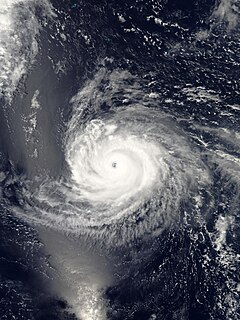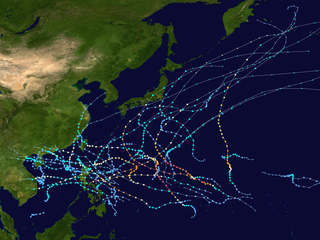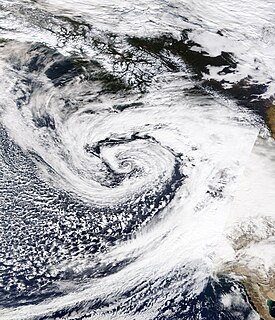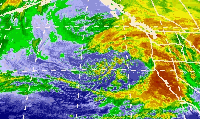
The 1997 Pacific hurricane season was a very active hurricane season. With hundreds of deaths and hundreds of millions of dollars in damage, this season was one of the costliest and deadliest Pacific hurricane seasons. This was due to the exceptionally strong 1997–98 El Niño event. The season officially started on May 15, in the eastern Pacific, and on June 1, in the central Pacific, and lasted until November 30. These dates conventionally delimit the period of each year when almost all tropical cyclones form in the northeastern Pacific Ocean.

The 2004 Pacific typhoon season was an extremely active season that featured the second-highest ACE ever recorded in a single season, second only to 1997, which featured 29 named storms, nineteen typhoons, and six super typhoons. It was an event in the annual cycle of tropical cyclone formation, in which tropical cyclones form in the western Pacific Ocean. The season ran throughout 2004, though most tropical cyclones typically develop between May and October. The season's first named storm and also the first typhoon, Sudal, developed on April 4, later was reached typhoon status two days later, and became the first super typhoon of the year three days later. The season's last named storm, Noru, dissipated on December 21.

The 2003 Pacific typhoon season was a slightly below average yearlong period of tropical cyclogenesis exhibiting the development of 45 tropical depressions, of which 21 became named storms; of those, 14 became typhoons. Though every month with the exception of February and March featured tropical activity, most storms developed from May through October. During the season, tropical cyclones affected the Philippines, Japan, China, the Korean Peninsula, Indochina, and various islands in the western Pacific.

The 2002 Pacific typhoon season was a slightly above average Pacific typhoon season, producing twenty-six named storms, fifteen becoming typhoons, and eight super typhoons. It was an event in the annual cycle of tropical cyclone formation, in which tropical cyclones form in the western Pacific Ocean. The season ran throughout 2002, though most tropical cyclones typically develop between May and October. The season's first named storm, Tapah, developed on January 11, while the season's last named storm, Pongsona, dissipated on December 11. The season's first typhoon, Mitag, reached typhoon status on March 1, and became the first super typhoon of the year four days later.

The 1997 Pacific typhoon season was a record-breaking season featuring 11 tropical cyclones reaching super typhoon intensity, tying the record with 1965 with the most violent tropical cyclones globally. It has no official bounds; it ran year-round in 1997, but most tropical cyclones tend to form in the northwestern Pacific Ocean between May and November. These dates conventionally delimit the period of each year when most tropical cyclones form in the northwestern Pacific Ocean.

The 1986 Pacific typhoon season has no official bounds; it ran year-round in 1986, but most tropical cyclones tend to form in the northwestern Pacific Ocean between May and December. These dates conventionally delimit the period of each year when most tropical cyclones form in the northwestern Pacific Ocean. Tropical Storms formed in the entire west pacific basin were assigned a name by the Joint Typhoon Warning Center. Tropical depressions that enter or form in the Philippine area of responsibility are assigned a name by the Philippine Atmospheric, Geophysical and Astronomical Services Administration or PAGASA. This can often result in the same storm having two names.

Hurricane Ioke, also referred to as Typhoon Ioke, had the highest accumulated cyclone energy (ACE) of any tropical cyclone on record. The first and only storm to form in the Central Pacific in the 2006 Pacific hurricane season, Ioke was a record breaking, long-lived and extremely powerful storm that traversed the Pacific for 17 days, reaching the equivalent of Category 5 status on the Saffir–Simpson hurricane scale on three different occasions. It was the most intense hurricane ever recorded in the Central Pacific, as well as the fifth-most intense Pacific hurricane on record, tied with 1973's Hurricane Ava. Ioke was the ninth named storm, fifth hurricane, and third major hurricane of the active 2006 Pacific hurricane season.

Hurricane Lester was the first Pacific tropical cyclone to enter the United States as a tropical storm since 1967. The fourteenth named storm and eighth hurricane of the 1992 Pacific hurricane season, Lester formed on August 20 from a tropical wave southwest of Mexico. The tropical storm moved generally northwestward while steadily intensifying. After turning to the north, approaching the Mexican coast, Lester attained hurricane status. The hurricane reached peak winds of 85 mph (140 km/h) before making landfall on west-central Baja California. The system weakened while moving across the peninsula and then over northwestern Mexico. Not long after entering Arizona, Lester weakened to a tropical depression, and degenerated into an extratropical low on August 24, 1992, over New Mexico. The storm's remnants later merged with the remnants of Hurricane Andrew and another frontal system on August 29.

The January 2008 North American storm complex was a powerful Pacific extratropical cyclone that affected a large portion of North America, primarily stretching from western British Columbia to near the Tijuana, Mexico area, starting on January 3, 2008. The system was responsible for flooding rains across many areas in California along with very strong winds locally exceeding hurricane force strength as well as heavy mountain snows across the Cascade and Sierra Nevada mountain chains as well as those in Idaho, Utah and Colorado. The storms were responsible for the death of at least 12 people across three states, and extensive damage to utility services as well, as damage to some other structures. The storm was also responsible for most of the January 2008 tornado outbreak from January 7–8.

The 2009 Pacific typhoon season was a below average season that spawned only 22 named storms, 13 typhoons, and five super typhoons. It was also recognized as the deadliest season in the Philippines for decades. The first half of the season was very quiet whereas the second half of the season was extremely active. The season's first named storm, Kujira, developed on May 3 while the season's last named storm, Nida, dissipated on December 3.

Severe Tropical Storm Faxai, known in the Philippines as Tropical Storm Juaning, was a short-lived tropical storm that had minor effects on land. The twentieth named storm of the 2007 Pacific typhoon season, Faxai originated from a tropical depression over the open waters of the western Pacific Ocean in late October. The storm quickly strengthened, becoming a severe tropical storm on October 26 as it rapidly traveled toward the northeast. The storm became extratropical the following day as it brushed Japan. The remnants dissipated on October 28.

Typhoon Melor, known in the Philippines as Typhoon Quedan, was the second category 5 super typhoon in 2009. It interacted with Typhoon Parma in the first week of October southeast of Taiwan.

Tropical Storm Ignacio was a weak tropical cyclone affected parts of the western United States in August 1997. The 12th tropical cyclone and 9th named storm of the 1997 Pacific hurricane season, Ignacio formed west of Mexico from a weather disturbance embedded within a more broad system. It was classified as a tropical depression on August 17, and although it quickly intensified into a tropical storm, harsher environmental conditions caused it to begin weakening as the cyclone moved northward. On August 19, Ignacio transitioned into an extratropical cyclone as it approached California, where its remnants produced unprecedented August rainfall, numerous traffic accidents, and 78,000 power outages.

The effects of tropical cyclones in Europe and their extratropical remnants include strong winds, heavy rainfall, and in rare instances, tornadoes or snowfall. There are only two modern cyclones officially regarded as directly impacting mainland Europe while still fully tropical or subtropical: Hurricane Vince in 2005, which struck southwestern Spain as a tropical depression; and Subtropical Storm Alpha in 2020, which made landfall in northern Portugal at peak intensity. Hurricane Debbie in 1961 may have still been tropical when it made landfall in northwestern Ireland, but this is disputed. In 1842, it is believed that a hurricane struck Europe.

The March 2014 nor'easter was an extremely powerful extratropical cyclone that affected much of U.S. Gulf Coast, the eastern United States, eastern Canada, and Greenland. It was the most powerful winter storm of the 2013–14 North American winter storm season, being an unusually large winter storm as well, with its gale-force wind field becoming four times larger than that of Hurricane Sandy's extratropical remnant. The storm affected various parts of the Midwest, most of the Eastern Seaboard, as well as eastern Canada, bringing extremely powerful winds, and blizzard-like conditions.

Typhoon Phanfone, known in the Philippines as Typhoon Neneng, was a powerful tropical cyclone which affected Japan in early October 2014. It was the eighteenth named storm and the eighth typhoon of the 2014 Pacific typhoon season.

The December 2014 North American storm complex was a powerful winter storm that impacted the West Coast of the United States, beginning on the night of December 10, 2014, resulting in snow, wind, and flood watches. Fueled by the Pineapple Express, an atmospheric river originating in the tropical waters of the Pacific Ocean adjacent to the Hawaiian Islands, the storm was the strongest to affect California since January 2010. The system was also the single most intense storm to impact the West Coast, in terms of minimum low pressure, since a powerful winter storm in January 2008. The National Weather Service classified the storm as a significant threat, and issued 15 warnings and advisories, including a Blizzard Warning for the Northern Sierra Nevada.

Typhoon Songda, known in the Philippines as Typhoon Nina, was the fourth-costliest typhoon on record. The 18th named storm of the 2004 Pacific typhoon season, Songda developed on August 26 near the Marshall Islands. Following a path that Typhoon Chaba took nine days prior, Songda moved west-northwestward and strengthened quickly amid favorable conditions.

The October 2021 Northeast Pacific bomb cyclone was an extremely powerful extratropical cyclone that struck the Western United States and Western Canada in late October 2021. The storm was the third and the most powerful cyclone in a series of powerful storms that struck the region within a week. The cyclone tapped into a large atmospheric river and underwent explosive intensification, becoming a bomb cyclone on October 24. The bomb cyclone had a minimum central pressure of 942 millibars (27.8 inHg) at its peak, making it the most powerful cyclone recorded in the Northeast Pacific. The system had severe impacts across Western North America, before dissipating on October 26. The storm shattered multiple pressure records across parts of the Pacific Northwest. Additionally, the bomb cyclone was the most powerful storm on record to strike the region, in terms of minimum central pressure. The bomb cyclone brought powerful gale-force winds and flooding to portions of Western North America. At its height, the storm cut the power to over 370,500 customers across the Western U.S. and British Columbia. The storm killed at least two people; damage from the storm was estimated at several hundred million dollars. The bomb cyclone was compared to the Columbus Day Storm of 1962, in terms of ferocity.



















